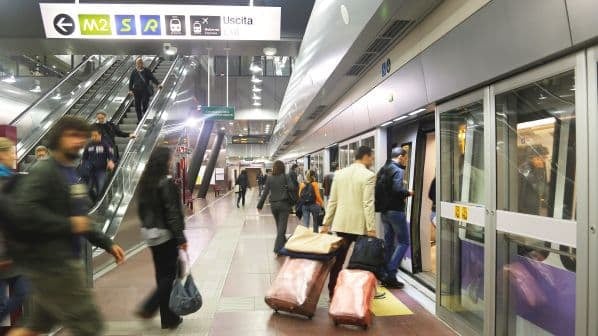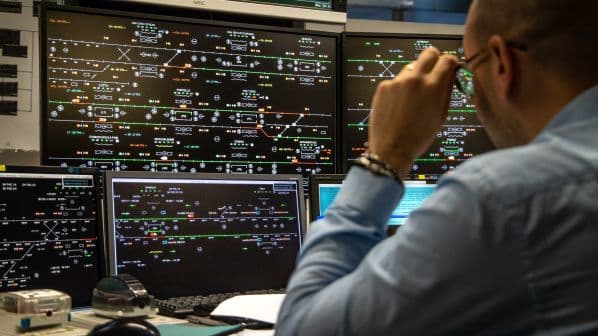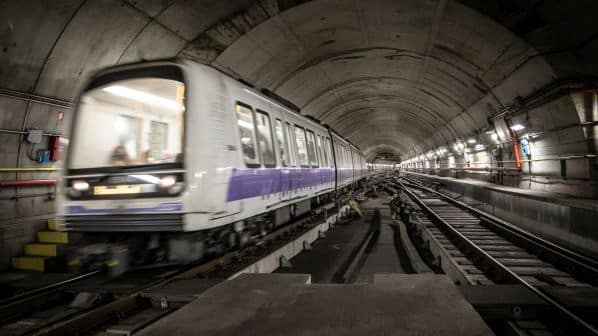MILAN celebrated another milestone in its public transport journey on July 4 with the opening of the latest extension of the M4 Blue Line on the city’s metro network. The 1.7km addition from Dateo to San Babila extends the entirely automated driverless line to 7km and provides an interchange with the M1 Red Line at San Babila, improving connectivity from the city centre to Linate Airport.
The first 5.3km Linate Airport - Dateo section opened in November and work is continuing to extend the line by a further 8.2km west to terminate at San Cristoforo. When completed in the second half of 2024, the line is expected to eliminate 4.43 million car journeys annually and cut CO2 emissions by 10,000 tonnes. Each train on the M4 Blue Line has capacity for up to 500 passengers and the line is expected to transport 24,000 people per hour, per direction.
The steady expansion of the metro network has been a feature of Milan’s growth in the 21st century. As well as M4, the city opened its first automated metro, the M5 Purple Line, in 2013, which was extended to 12.8km and 19 stations in 2015. At 118km and 119 stations, Milan will possess Europe’s sixth largest metro network once Line M4 is completed. Coupled with the 157km, 17-line tram network, a four-line, 38.8km trolleybus network, and 135 bus routes, the city’s extensive public transport network has also established Milan Transport (ATM) as a leading European operator.
Yet Milan, like all European cities, has suffered in the aftermath of the Covid-19 pandemic. Ridership and farebox revenue has only returned to 80-85% of pre-pandemic levels. ATM is also dealing with rising costs, both relating to the pandemic and the subsequent energy crisis. This has prompted the company to rethink its wider transport strategy, according to strategy, innovation and sustainability director, Mr Paolo Marchetti, who was speaking to IRJ at ATM’s city centre headquarters.
“In every crisis there is an opportunity,” Marchetti says. “For us, it is a chance to accelerate digitalisation and improve the quality of our services.”
Indeed, this is the central component of ATM’s revised strategy launched in 2021, which aims to make public transport more comfortable, accessible and sustainable while reinforcing ATM finances.
Marchetti describes the situation as chicken and egg: the operator has less money but is working in an environment where demand for public transport has changed. Rather than two daily peaks, ATM is experiencing a flatter curve of demand for services throughout the day and at weekends. He argues that this requires the company to invest in improved services that are attractive to a broader range of passengers, not just white collar commuters.
“Smart working has changed the demand curve for our services so now we have to work to attract our passengers back,” Marchetti says.
Passenger app
Among the immediate changes is the introduction of an updated passenger app, which is scheduled for 2024.
Users will continue to buy tickets, plan journeys and be informed of any disruption to ATM services using their smartphone. However, the new app will offer improved journey planning and make purchasing tickets easier. It will also offer users the option to select their favourite stops, personalising the service to meet their specific needs. In addition, users will be able to book multi-modal journeys, combining traditional modes of public transport with shared mobility services such as scooters and bicycles.
Marchetti says ATM is working hard with the providers of other transport services in Milan to provide a more comprehensive and compelling offer to its passengers. The city of Milan, has also backed this approach by introducing more bike lanes, which Marchetti says supports the development of a “smart city.”
“We don’t want our passengers to think about using a specific line, we want them to think simply about where they want to go,” Marchetti says. “Our response is a proposal that can combine metro, bus journeys and shared mobility options to deliver this journey from A to B. It will also do this for a single price. This is a win-win for us.
“With many of these new technologies we can also build other services and begin to reduce the gap between someone wanting to make a journey and actually doing it. Perhaps we can propose a special tram trip, or reduce the cost of a metro journey? This will attract more people to use public transport.”
Fare collection has also improved substantially since ATM introduced contactless ticketing on the metro network in 2018. More than 47 million transactions have been recorded since passengers have been able to use their bank card to travel seamlessly on metro lines across the city. The service was extended to the city’s tram, trolleybus and bus services in April following a €12m investment and the installation of 1500 contactless card readers.

“This is a good example of where we have improved the quality of service, but also increased the revenue,” Marchetti says. “In the past we had a problem on Sundays when the tobacconist was closed, people could not buy a ticket. People are now able to use the service and we can collect the revenue. Also, when the ticket machines are busy, you can just tap and go.”
Further improvements in passenger experience are apparent in enhanced passenger information. Marchetti reveals how improving the connectivity of vehicles through the introduction of more sophisticated CCTV is providing data on the potential for overcrowding, which can be used to instruct passengers to board at different sections of the platform. A new passenger counting system installed across the metro network is similarly helping to optimise passenger distribution.
New fleets on order will also enable ATM to offer further enhancements in service quality to its passengers.
The most significant single outlay so far has been on 46 new six-car metro trains. The €368m framework contract was awarded to Hitachi Rail in November 2022. Under the first part of the agreement, Hitachi will build 21 new trains at its plants in Naples and Reggio di Calabria for delivery into service on Line M1 in spring 2024. Crucially, in line with ATM’s strategy, the new design will be fully accessible and will offer “uninterrupted views from front to rear.” The trains will be equipped with a CCTV system as well as air-conditioning, and will offer a quieter onboard environment, improving the passenger experience.
We have a dedicated international business unit and we are focused on marketing our expertise in engineering and projects.
Paolo Marchetti, ATM’s strategy, innovation and sustainability director
Likewise, in June ATM awarded Stadler a framework contract to supply up to 50 Tramlink LRVs, comprising up to 25 medium-capacity and 25 high-capacity vehicles. The contract follows a €172.6m contract with Stadler for up to 80 medium-capacity LRVs signed in 2020, the first of which arrived in Milan in December 2022. Of these new LRVs, 50 will operate on the city centre network and 30 are for suburban lines.
Under the first call from the latest contract, ATM has ordered 14 five-section high-capacity LRVs, which will be delivered before June 30 2026. The step-free interiors of the low-floor LRVs will feature two specific areas for wheelchair users with the four doors on each side speeding boarding and reducing dwell times at stops. Stadler says the bogies will provide smoother operation through curves, helping to reduce noise. And like ATM’s new metro trains, the LRVs will have advanced CCTV and passenger information systems.
Electrification of its bus fleet is another priority for ATM’s fleet upgrade strategy. The operator is aiming to convert its entire bus fleet of more than 1200 vehicles to electric traction by 2030. This will cut diesel consumption by 30 million litres and reduce CO2 emissions by 75,000 tonnes annually. Currently there are 170 electric buses in service and this will grow to 250 by the end of the year.
ATM has prioritised plug-in electric vehicles so far, but Marchetti says that the authority is looking at charging by pantograph as another option in its all-electric plan. He adds that the company is also open to the possibility of using hydrogen as an alternative to electric traction.
ATM already sources 70% of its electricity from renewables and eliminating diesel will go a long way to delivering the company’s ambition to become net-zero. Energy saving is another focus, specifically through regenerative braking. ATM has also introduced driver advisory systems intended to encourage drivers to drive trains, trams and buses more economically.
Other sustainability improvements involve boosting accessibility - as reflected in the new fleet orders - and across the network more generally. “We have a plan that by 2026 metro lines 1, 2 and 3 will all be fully accessible,” Marchetti says. “This is one of our most important projects in recent years.”
Marchetti says that ATM is also encouraging its suppliers to transition to net zero by requiring companies to meet certain criteria in tenders. “We put a lot of work into areas relating to ESG criteria that are pushing towards the development of a sustainable ecosystem, for both our suppliers and our customers,” Marchetti says.
Business model
Work is also underway to adjust ATM’s business model in other areas to make up for the shortfall in farebox revenue. Improvements at stations are an obvious target. Marchetti reveals that under its hubs strategy, ATM is working to transform more of its flagship stations - such as Milan Central, Porta Garibaldi and Cadorna - into destinations for passengers, by improving retail and dining opportunities and encouraging more businesses to set up shop at major interchanges.
This is not an especially innovative strategy, as many other transport operators and railways have adopted similar practices with significant success. However, ATM is not limiting its efforts to major city centre hubs, but also looking at options to repurpose suburban and interchange stations. Among the examples Marchetti highlights are opportunities to attract car repair businesses to base themselves at suburban stations with park-and-ride facilities. The idea is that these businesses can service a customer’s car while they travel into town, completing the job before they return.
Another project aims to encourage charities to open shops at interchange stations. While not as attractive to major retailers, Marchetti says the stations will benefit from this physical presence, which may encourage further development in the future. He says the experience of setting up drop-in Covid-19 vaccination clinics at stations showed that alternative uses are viable.
Revisions to ATM’s advertising strategy are another priority. Marchetti says that ATM is working with retailers of advertising space on rail infrastructure across the city to introduce new digital screens and signage to provide a more compelling offer to their clients.

Interestingly, ATM is not putting all of its eggs in its Milan basket. The company recognises that opportunities outside of Milan offer potentially lucrative opportunities to further grow revenue. ATM has already dabbled in international projects, operating the steadily expanding Copenhagen driverless metro network since it opened in 2008, and securing a contract for operation and maintenance of the city’s new 28km light rail line, which is due to open next year. It also won a contract to provide consultancy services during the early stages of Riyadh’s automated metro project in 2011.
More recently, ATM secured a contract in June to manage and maintain the under-construction 20km driverless metro line in the Greek city of Thessaloniki, which is on course to finally open in early 2024 after work got underway as long ago as 2006. ATM is the lead partner (51%) with Egis Rail (49%) in the Thessaloniki Metro Automatic joint venture, which has been awarded an 11-year contract worth €250m. The 9.6km line from Neos Sidirodromikos Stathmos to Thessaloniki main station and a 4.7km extension to Kalamaria will be operated with a fleet of 33 driverless metro trains supplied by Hitachi Rail Italy using the same CBTC at GoA4 technology used in Milan and Copenhagen.
ATM’s strong presence at the recent International Association of Public Transport (UITP) World Congress in Barcelona reflects the authority’s desire to engage with and expand its work to other markets. Marchetti says Europe and potentially greenfield projects in the Middle East are of particular interest. He expects ATM to bid for more contracts in the coming years. “We have a dedicated international business unit and we are focused on marketing our expertise in engineering and projects,” he says.
Strong expertise in automated operation with CBTC is an area where ATM hopes to stand out from the competition. It will also not stand still at home. Future improvements include opportunities to introduce dynamic and on-demand services, especially on the bus network, which is more responsive to needs at specific times of the day and to events that might be happening across the city. As Marchetti puts it, the operator simply wants to find an easier way for its passengers to move. An openness to using new technologies in different ways will provide ATM with the chance to deliver on this objective.
“There was a lesson that Covid taught us: you have to be open to new opportunities,” Marchetti says.

